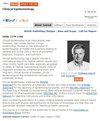Estimation of Personal Symptom Networks Using the Ising Model for Adult Survivors of Childhood Cancer: A Simulation Study with Real-World Data Application
IF 3.2
2区 医学
Q1 PUBLIC, ENVIRONMENTAL & OCCUPATIONAL HEALTH
引用次数: 0
Abstract
Purpose: Childhood cancer survivors experience interconnected symptoms, patterns of which can be elucidated by network analysis. However, current symptom networks are constructed based on the average survivors without considering individual heterogeneities. We propose to evaluate personal symptom network estimation using the Ising model with covariates through simulations and estimate personal symptom network for adult childhood cancer survivors.Patients and Methods: We adopted the Ising model with covariates to construct networks by employing logistic regressions for estimating associations between binary symptoms. Simulation experiments assessed the robustness of this method in constructing personal symptom network. Real-world data illustration included 1708 adult childhood cancer survivors from the St. Jude Lifetime Cohort Study (SJLIFE), a retrospective cohort study with prospective follow-up to characterize the etiology and late effects for childhood cancer survivors. Patients’ baseline symptoms in 10 domains (cardiac, pulmonary, sensation, nausea, movement, pain, memory, fatigue, anxiety, depression) and individual characteristics (age, sex, race/ethnicity, attained education, personal income, and marital status) were self-reported using survey. Treatment variables (any chemo or radiation therapy) were obtained from medical records. Personal symptom network of 10 domains was estimated using the Ising model, incorporating individual characteristics and treatment data.
Results: Simulations confirmed the robustness of the Ising model with covariates in constructing personal symptom networks. Real-world data analysis identified age, sex, race/ethnicity, education, marital status, and treatment (any chemo and radiation therapy) as major factors influencing symptom co-occurrence. Older childhood cancer survivors showed stronger cardiac-fatigue associations. Survivors of racial/ethnic minorities had stronger pain-fatigue associations. Female survivors with above-college education demonstrated stronger pain-anxiety associations. Unmarried survivors who received radiation had stronger association between movement and memory problems.
Conclusion: The Ising model with covariates accurately estimates personal symptom networks. Individual heterogeneities exist in symptom co-occurrence patterns for childhood cancer survivors. The estimated personal symptom network offers insights into interconnected symptom experiences.
Keywords: bootstrap testing, individual heterogeneity, Ising model, network analysis, sociodemographic
使用伊辛模型估计儿童癌症成年幸存者的个人症状网络:真实世界数据应用模拟研究
目的:儿童癌症幸存者会出现相互关联的症状,这些症状的模式可通过网络分析加以阐明。然而,目前的症状网络是根据幸存者的平均水平构建的,没有考虑个体的异质性。我们建议通过模拟评估使用带有协变量的 Ising 模型估计个人症状网络,并估计成年儿童癌症幸存者的个人症状网络:我们采用了带有协变量的 Ising 模型,通过逻辑回归估算二元症状之间的关联来构建网络。模拟实验评估了这种方法在构建个人症状网络时的稳健性。真实世界的数据说明包括圣裘德终生队列研究(SJLIFE)中的1708名成年儿童癌症幸存者,该研究是一项具有前瞻性随访的回顾性队列研究,旨在描述儿童癌症幸存者的病因和晚期影响。患者在 10 个方面(心脏、肺部、感觉、恶心、运动、疼痛、记忆、疲劳、焦虑、抑郁)的基线症状和个人特征(年龄、性别、种族/民族、受教育程度、个人收入和婚姻状况)均通过调查进行自我报告。治疗变量(化疗或放疗)来自医疗记录。利用伊辛模型,结合个人特征和治疗数据,估算出了 10 个领域的个人症状网络:结果:模拟证实了伊辛模型在构建个人症状网络时的稳健性。真实世界的数据分析表明,年龄、性别、种族/民族、教育程度、婚姻状况和治疗(任何化疗和放疗)是影响症状共同发生的主要因素。年龄较大的儿童癌症幸存者表现出更强的心因性疲劳关联。少数种族/族裔幸存者的疼痛-疲劳关联性更强。受过大学以上教育的女性幸存者表现出更强的疼痛-焦虑关联。接受过放射治疗的未婚幸存者在运动和记忆问题之间有更强的关联:结论:带有协变量的 Ising 模型能准确估计个人症状网络。儿童癌症幸存者的症状共现模式存在个体异质性。估计的个人症状网络有助于深入了解相互关联的症状体验。
本文章由计算机程序翻译,如有差异,请以英文原文为准。
求助全文
约1分钟内获得全文
求助全文
来源期刊

Clinical Epidemiology
Medicine-Epidemiology
CiteScore
6.30
自引率
5.10%
发文量
169
审稿时长
16 weeks
期刊介绍:
Clinical Epidemiology is an international, peer reviewed, open access journal. Clinical Epidemiology focuses on the application of epidemiological principles and questions relating to patients and clinical care in terms of prevention, diagnosis, prognosis, and treatment.
Clinical Epidemiology welcomes papers covering these topics in form of original research and systematic reviews.
Clinical Epidemiology has a special interest in international electronic medical patient records and other routine health care data, especially as applied to safety of medical interventions, clinical utility of diagnostic procedures, understanding short- and long-term clinical course of diseases, clinical epidemiological and biostatistical methods, and systematic reviews.
When considering submission of a paper utilizing publicly-available data, authors should ensure that such studies add significantly to the body of knowledge and that they use appropriate validated methods for identifying health outcomes.
The journal has launched special series describing existing data sources for clinical epidemiology, international health care systems and validation studies of algorithms based on databases and registries.
 求助内容:
求助内容: 应助结果提醒方式:
应助结果提醒方式:


